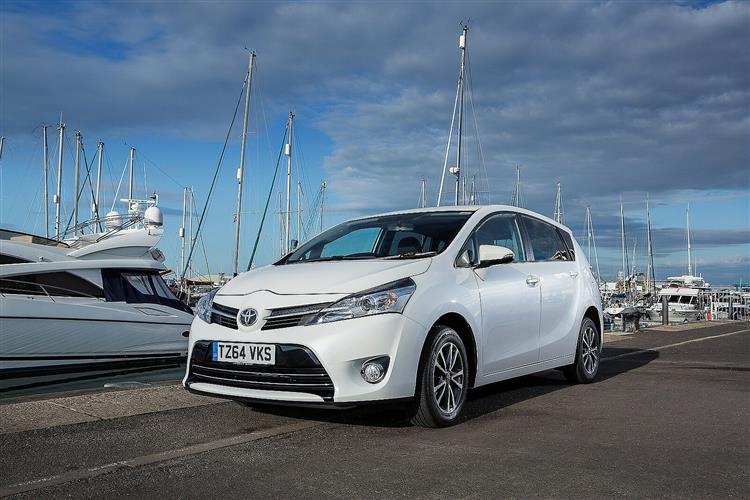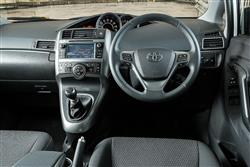CHAPTER & VERSO (some text hidden) --NONE--
By Jonathan Crouch
Introductionword count: 59
What do people look for in a mid-sized, seven-seat family people carrier? Good build quality, neat packaging, a versatile seating system, a reputation for reliability and a choice of frugal engines? The much improved version of the MK3 Verso MPV that Toyota launched in 2013 certainly ticks all those boxes. But does it make sense as a used buy?
Modelsword count: 10
5dr MPV ([petrol]1.6 V-matic / [diesel] 1.6 D-4D, 2.0 D-4D)
Historyword count: 186
This is the third generation version of Toyota's compact family-sized MPV, a vehicle we first saw in 2001 badged as the 'Corolla Verso'. That model only had five seats, but a MK2 seven-seater design followed in 2004, before this MK3 version made its debut in 2009, also with up to seven seats, but by now branded purely as 'Verso'. It was an exceptionally competent car, but it wasn't one you'd necessarily find reasons to try and buy and too often for Toyota's liking, potential buyers passed up the opportunity for ownership in favour of more stylish or perhaps more dynamic options in the compact people carrying segment. Hence the need for this revised third generation version, introduced at the end of 2012 and targeted at leaving more of a lasting impression. On the balance sheet, with lower running costs. On the road with extra refinement, revised suspension and sharper steering. And on your driveway with sharper looks and extra equipment. A car, in essence, to cover all your family transport needs, chapter and verso, in a way you'll feel good about. This car sold until 2018.
What You Getword count: 584
Toyota was keen to stress that the changes made to this third generation Verso in 2013 went a bit deeper than was usual with a mid-term facelift wash 'n brush-up. In all, over 470 parts were changed at this time, 60% of them visible, and the car was also 20mm longer than before. What you'll notice most though, if you owned the original post-2009 version of this model, is the brand's updated family face, the so-called 'keen' look we first saw on the company's second generation Auris family hatch. It certainly gives this Verso a more purposeful stance, dominated at the front end by a large trapezoidal lower grille set within a redesigned bumper and a smaller upper grille which features a chrome-plated horizontal trim bar and runs the full width between sleeker headlamp units that incorporate daytime running lights. Moving to the side, where there are smaller, more aerodynamically efficient door mirrors, the trademark dual-zone styling remains as before, with a strong character line flowing from the leading edge of the front bumper, rising through the lower edge of the doors, then sweeping up through the rear pillar to define the line of the rear, roof-mounted spoiler. It all nicely sets off rearward styling that, as at the front, also features extra chrome decoration, a revised bumper design and smarter light clusters. What didn't change in 2013 were the essential dimensions of this car - wheelbase, height and width - all of which means that there's no more space inside. So, as with virtually all compact seat MPVs, the third row seating you get in almost all models is really intended for children. If you really must put adults here, you'll find it fortunate that the seats recline. To keep bigger folk happy even on short journeys though, you're probably going to need to go a bit further than that and persuade those in the middle seating row to make use of the 195mm backwards and forwards sliding range that's on offer to enable some kind of passenger legroom compromise to be reached. This rear bench is really shaped for two, though three kids could be squeezed in if need be. There's plenty of storage space up-front too, with a spacious centre console box, decently sized door pockets and a twin-compartment glovebox with a cooled upper section that's big enough to hold a 1.5-litre bottle, plus an 8.2-litre lower section. In other words, everything is just as sensible as it was before, with the so-called 'Smart Wave Dynamism' dashboard design placing the gear lever comfortably close to the steering wheel, just where you'd want it. What's different though, in this improved Verso, is that all this sense and sensibility is a good deal nicer to live with thanks to tasteful trim improvements. Notably the softer satin black paint finish and the warm satin chrome highlights you'll find everywhere from the air vents to the instrument panel. And boot space? Well with all the seats occupied (a rare scenario for likely buyers), there's 155-litres of luggage room though you do get 11-litres of under-floor storage, enough to hold three six-pack cases of 1.5-litre plastic bottles. Use the neat Toyota 'Easy Flat' seating system - said to provide 32 different seating permutations - and fold the rearmost row into the floor and your available cargo space increases to 440-litres. In seven-seat models, that rises to 982-litres with the middle row also folded down to create a totally flat surface that's 1,575mm long and 1,430mm wide.
To see the full road test text contact us on 0330 0020 227
Pictures (high res disabled)

.jpg)
|
.jpg)
|
.jpg)
| |||
.jpg)
|
.jpg)
|
.jpg)
| |||
.jpg)
|
.jpg)
|

|
Scoring (subset of scores)
Category: MPV People Carriers
| Performance | |
| Handling | |
| Comfort | |
| Space | |
| Styling, Build, Value, Equipment, Depreciation, Handling, Insurance and Total scores are available with our full data feed. | |



